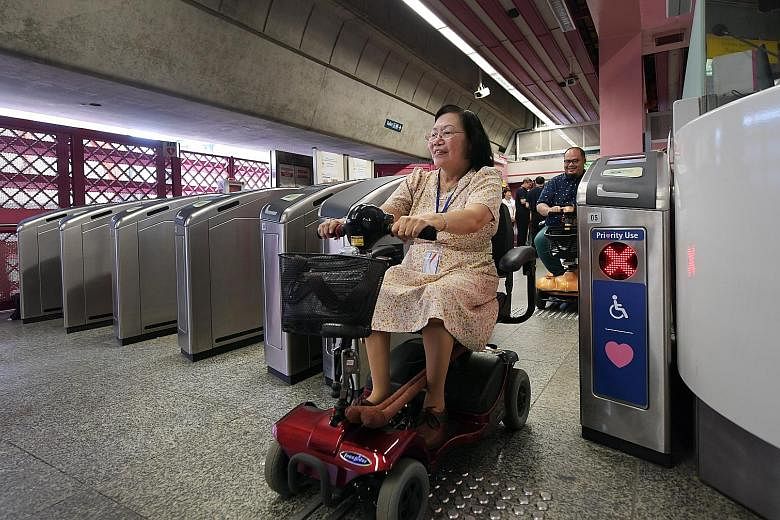A trial of a hands-free payment system is set to be carried out on the rail network and public buses, in a move to make the public transport system more inclusive.
The Land Transport Authority (LTA) called a tender earlier this month, inviting companies to design and trial a system that will allow commuters, especially those with disabilities and the elderly, to pass through fare gates or board buses without tapping fare cards.
According to tender documents, the system will use either radio frequency identification (RFID) or Bluetooth technology, with sensors built in to detect the fare card on a commuter and deduct his fare.
An LTA spokesman told The Straits Times that the trial is part of ongoing efforts to "foster an inclusive public transport system".
The concept of a hands-free automated fare collection system was first mooted in 2015, when the LTA sought ideas from the industry on the technology and equipment needed for such a system.
The LTA had conducted a similar trial of a hands-free ticketing system at four MRT stations in collaboration with ST Engineering, from June to November 2018.
A trial for hands-free payment on buses took place that year as well.
The LTA did not address queries about the outcome of the 2018 trials, and why it is looking to test a hands-free payment system again.
The latest trial is projected to take nine months.
Based on tender documents, companies can devise a piece of wearable RFID technology or smartphones with Bluetooth technology as alternatives to fare cards with RFID chips.
These will not need to be put near the fare reader and can be kept in a bag or pocket.
Under LTA's specifications, the system's sensors should be intelligent enough to distinguish between a commuter walking through the fare gate and a commuter who is simply passing by.
The LTA intends for this system to be capable of serving passengers in manual or motorised wheelchairs, those using walking frames or aids, and passengers who are certified as "mobility challenged".
Contractors have also been asked to submit a proposal for implementing the hands-free payment system islandwide, on a scalable and cost-effective basis.
According to tender documents, this system would be installed on 6,000 buses and 400 MRT fare gates should it be implemented islandwide.
Ms Ku Geok Boon, chief executive of SG Enable, which supports people with disabilities, said that tapping the fare card at the gantry is a hassle for those using mobility aids.
"A hands-free payment system will significantly increase ease of travel for commuters," she said.
Ms Tan Li Li, 49, who lives with poliomyelitis and uses a motorised wheelchair to get around, was one of 22 commuters who took part in the 2018 trial.
On her daily commute, she would tap in at Jurong East MRT station as usual and exit at Tiong Bahru station using the hands-free system.
She told The Straits Times that normal MRT fare readers are too high for her to reach easily, and can be time-consuming to use.
But exiting via the hands-free system was a breeze.
Ms Tan, who does book binding and restoration at SPD - formerly the Society for the Physically Disabled - would like to see such a system on buses as well, and extended to the whole island.
Ms Tay Soong Kiang, director of corporate services for SPD, said some people with disabilities struggle to tap their cards at fare gates due to functional limitations, such as a lack of strength or limited extension of their arms.
Hands-free fare gates will also benefit others with similar mobility issues like the elderly, she said, adding: "Efforts like this to make our public transportation more inclusive is a step towards encouraging greater social integration in the community."

